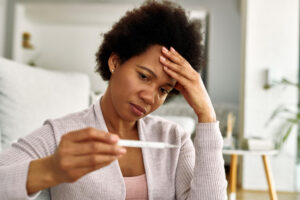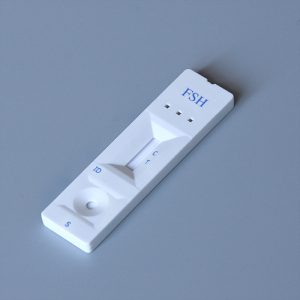Ovulation tests are urine tests that help you track your fertile days. They are also called ovulation predictor kits, OPKs, or LH tests. These tests detect the presence of the luteinizing hormone (LH) in your urine, which is a sign that you might be close to ovulating.
Using these tests can help you time intercourse around your fertile window. When you get a positive ovulation test, it’s a sign that you are likely fertile. It’s more reliable than some fertility symptoms like ovulation pain.
Ovulation tests can be useful, but they have a few important limitations:
- These tests tell you that your body is trying to ovulate, but they don’t confirm that ovulation occurred. It’s possible to release LH and not go on to ovulate.
- Some women find the tests annoying to use, and the results can sometimes be difficult to interpret.
How and when to take ovulation tests
You should always follow the included instructions about when to take ovulation tests, because there may be slight variations between test brands.
When to take standard ovulation tests
When using standard ovulation tests, begin testing several days before you expect your LH surge to begin. The LH surge usually begins 1-2 days before ovulation, though this can vary from woman to woman. If your cycles are irregular, or you have no idea when you ovulate, you can begin testing a few days after your period ends.
What time of day to take ovulation tests
Does it matter what time of day you take ovulation tests? Many women can test at any time of day, assuming urine is not too dilute (this is why it’s recommended to avoid drinking excessive amounts of liquids and avoid urinating for at least two hours before testing).
It’s often recommended to avoid testing first thing in the morning. The reason for this is that the LH surge typically occurs between midnight and 8 am and may not be apparent in the first morning urine. If you have a relatively short LH surge and you only test in the morning, it might be over by the time you test the next morning and you would never see a positive result.
But for many women, the LH surge is long enough that this is not a problem. Since your personal LH pattern tends to be similar from cycle to cycle, if you see a positive result in the morning on one cycle, you can safely assume that you will be able to catch your surge with morning testing only on subsequent cycles.
How long after a positive ovulation test do you ovulate?
Ovulation occurs, on average, 24 hours after the LH surge first begins, though this can vary from woman to woman.
It doesn’t matter how long the LH surge lasts because it’s the initial surge in LH that triggers ovulation. Ovulation typically occurs the day after your first positive ovulation test.
It’s a good idea to start taking ovulation tests several days before you expect your LH surge to begin. This way, when you get a positive result you can be reasonably certain that you’ve caught the beginning of your surge.
Also, keep in mind that there is profound variability in how long after the LH surge ovulation occurs. This means that you might ovulate the day after a positive test, the day of a positive test, several days after … or you might not ovulate that cycle at all.
What’s more, women with long cycles or PCOS may experience multiple LH surges within a single cycle before they successfully ovulate.
Does a faint ovulation test line mean ovulation is coming?
It can be confusing to decipher standard ovulation test results. You should expect to see two lines throughout most of your cycle because you always have baseline levels of LH in your body. It’s only when the test line is as dark or darker than the control line that you have a positive ovulation test.
The pattern of the line getting darker will vary from woman to woman. You might notice your test line gradually getting darker over the course of a day or two, or you might go from a very faint test line to a blazing positive in the same day.
And remember, a positive ovulation test doesn’t guarantee that you will ovulate—it’s only an indication that your body is gearing up for ovulation. Think of a positive ovulation test like a weather forecast. Just because the weatherman says it’s going to rain tomorrow, doesn’t mean it absolutely will.
How many days are you fertile after an LH surge?
Most women are fertile for 1 – 2 days after the LH surge. Ovulation occurs an average of 24 hours after the LH surge first begins, though this figure varies from woman to woman. Your fertile window includes the 5 days before ovulation and the day of ovulation itself.
However, the very best days to get pregnant are the 2 – 3 days before ovulation—multiple studies have shown that having sex these days carries even higher chances of pregnancy than the day of ovulation itself.
Do you always get an LH surge before ovulation?
Yes—the LH surge is necessary for ovulation to occur. LH erodes the wall of the ovarian follicle producing a “stigma” or hole through which the ovum is released.
The length of the LH surge varies considerably from woman to woman. It can be under 12 hours or several days long. If your LH surge is on the shorter side, it might be more difficult to catch it with an ovulation test.
Does LH drop after ovulation?
Eventually, yes. But how long it takes for LH to drop can vary from woman to woman.
If you have a long LH surge, you might have multiple positive test days in a row. You can ovulate any time after the first positive result.




